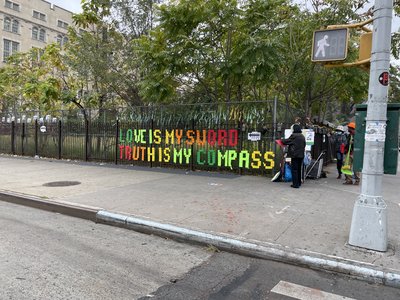The lot behind Erasmus Hall High School at the corner of Bedford and Church avenues has been vacant since P.S. 90 was demolished in 2016.
The land was then turned over to the Department of Housing Preservation and Development (HPD), who began searching for a private partner who could help create an affordable housing development on the site.
However, recent research has found that the intersection might be more important than originally thought.
Maps of the land from the 1800s designate it as a burial site for African Americans. It is believed to have been a segregated section of the Flatbush Reformed Church Cemetery, which remains intact to this day.
Further research into the site by groups such as the Flatbush African Burial Ground Coalition (FABGC) uncovered the names of some people buried there, including African and indigenous individuals who were enslaved on nearby farms.
As a result of these findings, the FABGC has pushed city officials to terminate the project. Last month, the group held a rally outside Borough Hall demanding Borough President Eric Adams support preserving the burial site.
“A burial ground should not be slated for real estate development,” said Father Sheldon Hamblin from St. Paul’s Episcopal Church . “When the community knows about these things there is pushback, so we must get the word out.”
Adams, who is running for mayor, responded this past week with a statement calling on Mayor Bill de Blasio to suspend the affordable housing project.
“This is crucial not only to respect the dead, but to respect our history,” he wrote. “It’s desecration and it has to be stopped.”
Previously, Adams supported the affordable housing project and even co-chaired a task force with Councilman Mathieu Eugene to determine how to best develop the land.
In his letter to the mayor, Adams was clear that he still supports affordable housing projects in Flatbush, but believes that the city should find alternative sites.
“Our borough absolutely needs to build more affordable housing,” Adams said. “But I cannot support building it on an area shown to have human remains of enslaved peoples below.
“This is not just NIMBY-ism coming from the Black community,” he added. “You just don’t build on top of gravesites. As people are awakening to this concept of Black lives matter, they don’t only matter when they are alive. They matter when they are laying in their graves.”
Adams argues the land should be turned over to the New York City Economic Development Corporation to consider new uses for the site.
FABGC, however, remains strictly opposed to any development at the site. The group is planning a community day of action and remembrance on October 30 to advocate for the continued protection of the site.
“My hope is to see us come together to see what is the best thing we can do for the community,” Eugene said of the current controversy. “If the community decides that we should create something that will remind us of the struggle our ancestors went through, I don’t have any problem with that.”



